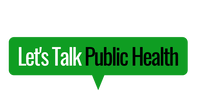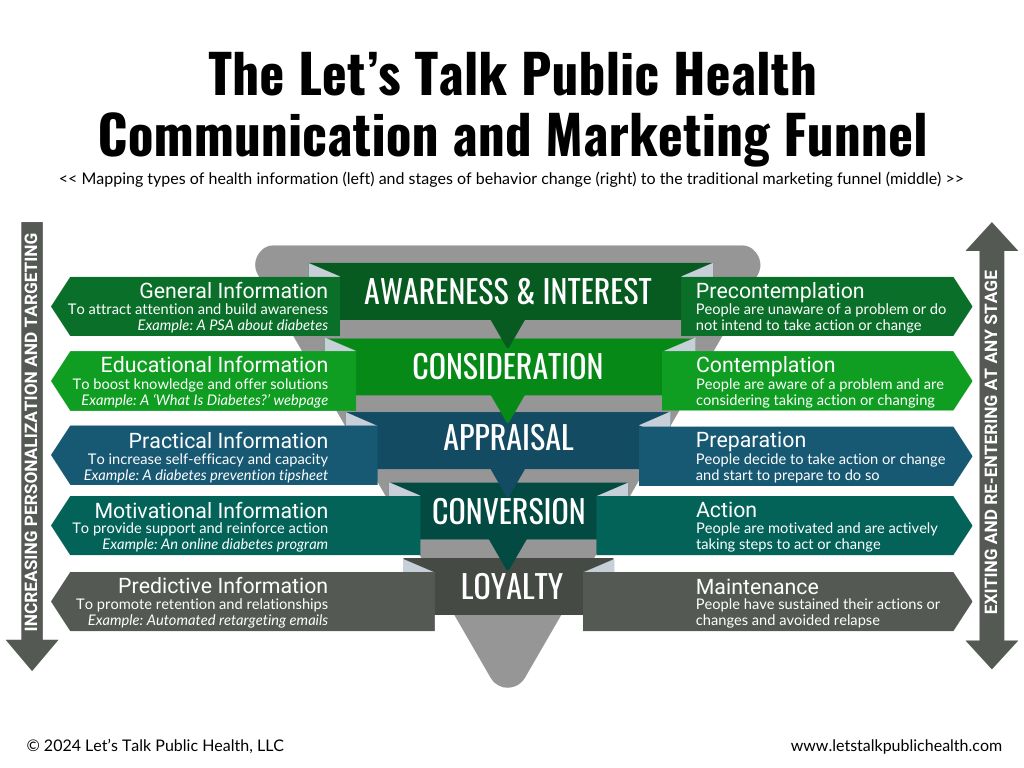Last updated: February 15, 2024
TABLE OF CONTENTS
- What Is It?
- Why Is It Necessary?
- How Does It Work?
- How To Apply It? (Coming in July)
What Is It?
Historically, public health has been good at building awareness and interest in public health problems and issues, but not so much at moving people to actual behavior change. [1,2] This is where the LTPH Communication and Marketing Funnel comes in. The funnel maps the stages of behavior change (a commonly used theoretical framework for creating health communication, health promotion, and social marketing campaigns) with the traditional marketing funnel (a commonly used framework for creating commercial marketing campaigns) and provides insights into the types of information needed in your materials and messages to drive behavior change.
Why Is It Necessary?
Professionals working in health communication, health promotion, and social marketing (who are typically focused on improving social good by changing health-related behaviors) must contend with several of the same challenges as professionals working in commercial marketing (who are typically focused on generating profits by influencing purchasing behaviors):
Though conversion may mean different things (influencing health-related behaviors vs. purchasing behaviors), the need is still the same: We have to shift people from being unaware of or uninterested in a public health problem or commercial product to taking action to address the problem or buy the product, and then maintaining their actions or purchases. This process can also include addressing people’s current loyalties (this could be behaviors contributing to a public health problem or purchases from a different brand in the same product category).
- The average attention span is 47 seconds. [3]
- The shelf life of digital and social media content is limited. [4]
- People need at least 3 to 10 exposures to an ad for maximum persuasive impact. [5]
- It takes an average of 66 days to form a new habit. [6]
Though conversion may mean different things (influencing health-related behaviors vs. purchasing behaviors), the need is still the same: We have to shift people from being unaware of or uninterested in a public health problem or commercial product to taking action to address the problem or buy the product, and then maintaining their actions or purchases. This process can also include addressing people’s current loyalties (this could be behaviors contributing to a public health problem or purchases from a different brand in the same product category).
How Does It Work?
The LTPH Communication and Marketing Funnel is designed around the Transtheoretical Model (TTM), the most commonly used theoretical model of behavior change across a broad range of health behaviors. [7] Theories such as this one anchor and drive the design and implementation of health communication, health promotion, and social marketing campaigns, and improve the effectiveness of those campaigns. [8] TTM recognizes that behavior change involves numerous actions and adaptations over time and that people are at varying stages of readiness to change. The model outlines six stages of change (marked by BOLD CAPITALIZED TEXT), ten processes of change and two principles of change (marked by underlined text).
The LTPH Communication and Marketing Funnel connects each stage of change in TTM with its corresponding stage in the marketing funnel and provides the specific message and material type needed to engage the process(es) of change for that stage. By engaging the appropriate process(es) of change, health communication, health promotion, and social marketing campaigns can foster a shift to the next stage and move people closer to behavior change.
So what types of messages and materials should you include in your health communication, health promotion, and social marketing campaigns to drive behavior change?
The LTPH Communication and Marketing Funnel connects each stage of change in TTM with its corresponding stage in the marketing funnel and provides the specific message and material type needed to engage the process(es) of change for that stage. By engaging the appropriate process(es) of change, health communication, health promotion, and social marketing campaigns can foster a shift to the next stage and move people closer to behavior change.
So what types of messages and materials should you include in your health communication, health promotion, and social marketing campaigns to drive behavior change?
1. General Information
Campaign messages and materials that share general information about a health condition or behavior (e.g., what it is and its incidence, prevalence, morbidity and mortality) can increase awareness of that condition or behavior (consciousness raising) and prompt people to evaluate that condition or behavior’s potential to have a positive or negative impact on their environment (environmental reevaluation). Using personal testimonials, endorsements, and other narrative messages with strong emotional appeals from prominent or relatable people can also increase negative or positive emotions about a health condition or behavior (dramatic relief) and help move people from PRECONTEMPLATION into CONTEMPLATION.
- Tie-Ins to Other Theories: The Health Belief Model (HBM) posits that people's willingness to change their health behaviors is determined by their beliefs about health conditions and their consequences. General information that aligns people's "perceived susceptibility" to a health condition to their actual risk can get people to see that the condition is relevant to them. General information that connects the "perceived severity" of a health condition to its potential consequences can get people to consider behavior changes that prevent the health condition or minimize or eliminate its negative consequences.
2. Educational Information
Campaign messages and materials that share educational information about a health behavior, especially those that use visuals that model that behavior and message appeals based on values or other psychographics, can lead people to assess their current values and sense of self and realize the alignment of a positive health behavior or the misalignment of a negative health behavior with their identity and who they want to be (self-reevaluation). The goal with your messages and materials is to share information that tips decisional balance so that the pros of behavior change outweigh the cons. Increasing the pros of behavior change and decreasing the cons can shift people from ambivalence or indecision into PREPARATION.
- Tie-Ins to Other Theories: According to HBM, educational information that connects the "perceived benefits" of a recommended health behavior to the effectiveness of that behavior in preventing a health condition or minimizing or eliminating its negative consequences should increase the likelihood of someone accepting the recommended behavior. Additionally, educational information that minimizes the "perceived barriers" to performing a health behavior, by addressing stigma or misinformation for example or providing helpful tips and tricks, should increase the likelihood of someone accepting the recommended behavior.
3. Practical Information
Campaign messages and materials that share practical information can boost people’s confidence in their ability to perform a healthy behavior or resist the temptation of an unhealthy behavior (self-efficacy) and can empower them to commit to changing their behavior and taking ACTION (self-liberation).
- Tie-Ins to Other Theories: Social Cognitive Theory posits that "self-efficacy" plays a major role in whether people avoid or take on goals, tasks, and challenges. People with high self-efficacy are more likely to take on goals, tasks, and challenges. Practical information that breaks down a health behavior into smaller action steps; demonstrates peers performing these steps; and provides tools for managing stress, anxiety, or other psychological responses at each step can boost self-efficacy.
4. Motivational Information
Campaign messages and materials that provide motivational information can drive the initiation and continuation of healthy behaviors and/or the termination of unhealthy behaviors. Messages and materials that establish or connect people to positive social networks that motivate change (helping relationships), tools for substituting unhealthy behaviors and thoughts with healthy behaviors and thoughts (counter-conditioning), and ideas for replacing cues for unhealthy behaviors with cues for healthy behaviors (stimulus control) are key to supporting continued action. Employing praise, recognition, special privileges, and other tactics to reward healthy behavior and reduce the rewards that come from unhealthy behavior (reinforcement management) is key to moving people into MAINTENANCE.
- Tie-Ins to Other Theories: "Cues to action" are also a key construct in HBM. Tailoring and personalizing these cues can make them more meaningful and appropriate for your intended audience.
5. Predictive Information
Campaign messages and materials that provide personalized predictive information–information that is personalized to address current needs and proactively address future needs–are key to promoting ongoing maintenance and possibly TERMINATION. In the termination stage, people have no desire to return to their unhealthy behaviors and are 100% confident that they will not relapse. This stage is rarely reached, so it is not included in the funnel. The goal here is to keep people regularly engaged in preventative healthcare services. With artificial intelligence (AI) and machine learning (ML) technologies, there is the potential for using personalized data based on intake forms, electronic health records, mobile app usage, etc. to anticipate needs and send proactive messages and materials. [9] AI-ML technologies can create and send highly tailored, personalized campaign messages and materials that address individual concerns and provide customized recommendations to prevent relapse into unhealthy behaviors. [10] AI-ML technologies can also use predictive modeling to identify if people are engaged in other risky health behaviors, determine their readiness to change behaviors, and tailor and personalize the messages and materials they receive to initiate future behavior changes. [11] Currently, public health agencies and organizations aren’t readily equipped with advanced AI-ML technology, but a couple of well-timed automated email, text, and voice message workflows for follow-ups and reminders can do wonders. [12]
Need help with your health communication?
Let's Talk Public Health can conduct and support your health communication, marketing, promotion, and education-related activities. We provide services for digital communication and marketing, digital media design, edutainment and experiential learning, digital engagement, health branding, and capacity-building.
|
Highlights
Explore
Connect
|
© 2024 Let's Talk Public Health, LLC. All rights reserved. | View our Privacy policy | Terms of service | Disclaimer | Editorial policy.

